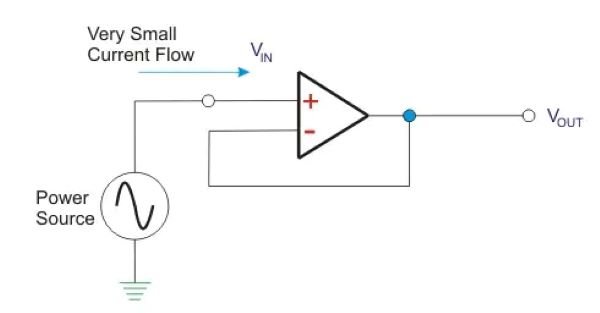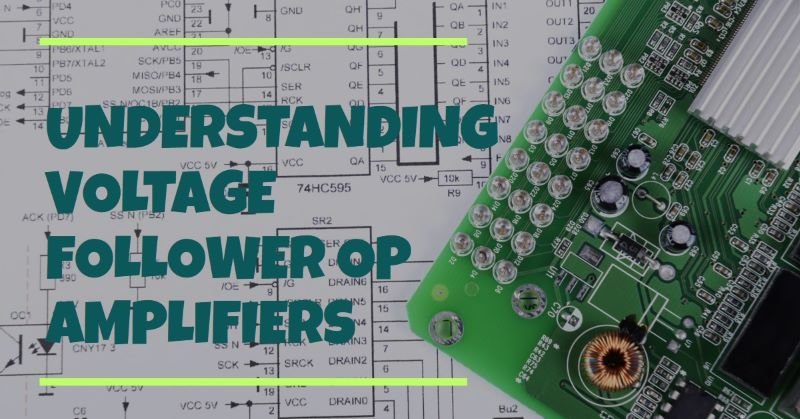Voltage Follower OP Amplifier: What is it?(Gain & Circuit Diagram)
What is a Voltage Follower?
A voltage follower, also known as a buffer amplifier, unity-gain amplifier, or isolation amplifier, is an operational amplifier (op-amp) circuit where the output voltage mirrors the input voltage. This means the voltage follower does not amplify or attenuate the input signal; instead, it has a voltage gain of 1, hence the name “unity-gain amplifier.”
A voltage follower, also referred to as a buffer amplifier, unity-gain amplifier, or isolation amplifier, is an operational amplifier (op-amp) circuit where the output voltage directly matches the input voltage. Essentially, the voltage follower does not amplify the input signal, resulting in a voltage gain of 1.
The primary function of a voltage follower is not to alter the signal’s strength but to serve as a buffer.
A defining feature of a voltage follower circuit is its extremely high input impedance. This makes it a go-to option in various circuits where isolating the input from the output is crucial.
Understanding the Voltage Follower Circuit

The circuit diagram of a voltage follower illustrates its simplicity. A fundamental principle behind its operation is Ohm’s law, which states that current in a circuit is the voltage divided by the resistance.
Since voltage followers have a very high input impedance (which means high resistance), they draw minimal current from the source.
To fully grasp how this works, it’s useful first to consider what happens in a circuit with low impedance. Low input impedance, and consequently low resistance, means the “R” in Ohm’s law is small.

With a constant voltage (V), a circuit with low impedance will draw a significant amount of current.
This results in the circuit consuming a large amount of power from the power source, which can lead to disturbances.
Now, if we apply this concept to a voltage follower circuit, we can see how it differs.
Operation of the Voltage Follower
In a voltage follower circuit, the output is connected directly to the inverting input of the op-amp. This setup forces the op-amp to adjust its output to match the input voltage. As a result, the output voltage “follows” the input voltage. As mentioned earlier, a voltage follower is characterized by a very high input impedance, typically between 1 MΩ and 10 TΩ, while its output impedance is low.
Despite maintaining the same voltage on both the input and output sides, the law of Ohm still applies. If the resistance drops significantly while the voltage remains constant, the current will increase dramatically. Although a voltage follower has a voltage gain of 1, it does not keep the current constant.
On the input side, the impedance is very high, which means the current is very low. On the output side, the impedance is very low, leading to a much higher current. In summary, the voltage remains unchanged, but the current increases due to the lower impedance between the input and output.
This high input impedance allows the op-amp to draw only a small amount of current from the source, minimizing the load. Meanwhile, the low output impedance enables the op-amp to drive the load effectively, as if it were a perfect voltage source. This setup reduces power consumption and minimizes distortion caused by overloading or electromagnetic interference.
Voltage Follower Gain
A voltage follower has a voltage gain of 1, meaning the output voltage exactly mirrors the input voltage. While the voltage gain of a voltage buffer amplifier is unity, it still offers significant current and power gain. This is why it’s commonly said that the voltage follower has a gain of 1, specifically referring to its voltage gain, which is equivalent to 0 dB.
Voltage Follower in Voltage Divider Circuits
In any electrical circuit, the voltage is distributed among the components based on their impedance or resistance. When an op-amp is included in the circuit, a significant voltage drop occurs across it due to its high input impedance.
In voltage divider circuits, a voltage follower ensures that the voltage across the load is maintained at the desired level.
Consider a voltage divider circuit that includes a voltage follower. The voltage divider is placed between two 10 KΩ resistors and the op-amp. The op-amp, with an input resistance of several hundred megaohms—let’s assume 100 MΩ—creates an equivalent parallel resistance of 10 KΩ || 100 KΩ.
This simplifies to 10KΩ || 10KΩ, and we know that a voltage divider with two equal resistances splits the power source voltage evenly.
Using the voltage divider formula, we can demonstrate that 5V will drop across the 10KΩ resistor at the top and 5V across the 10KΩ resistor at the bottom, as well as the load resistance of 100Ω (since 10 KΩ || 100Ω, the same voltage drops across parallel resistors).
The op-amp, acting as a buffer, ensures that the correct voltage is delivered to the load. Without the voltage follower, the circuit might fail to function properly due to insufficient voltage across the load.
In summary, voltage followers are primarily used in circuits for two main reasons: to provide isolation and to buffer the output voltage, ensuring the correct voltage reaches the connected load.
Advantages of Voltage Followers
Voltage followers offer several advantages, including:
- Significant Power and Current Gain: While the voltage gain is unity, the current and power gain can be substantial, making the follower useful in driving low-impedance loads.
- Low Output Impedance: This allows the voltage follower to drive loads efficiently, acting almost like a perfect voltage source.
- Minimal Input Current: The op-amp in a voltage follower draws virtually no current from the input, reducing the risk of loading effects.
- Isolation: Voltage followers provide isolation between the input and output, protecting sensitive components from high currents or voltages.
Applications of Voltage Followers
Voltage followers are widely used in various applications, including:
- Buffers for Logic Circuits: They isolate different stages of a circuit, preventing loading effects and ensuring signal integrity.
- Sample and Hold Circuits: Voltage followers are essential in maintaining the voltage level during the holding phase.
- Active Filters: They are used to buffer the stages of active filters, ensuring that the filter’s performance is not degraded by loading.
- Bridge Circuits: Voltage followers can buffer the output of a bridge circuit, such as those used with transducers, ensuring accurate signal processing.
Conclusion
In conclusion, a voltage follower is a versatile and essential component in many electronic circuits, providing the dual benefits of maintaining voltage stability while boosting current and power. Its high input impedance, low output impedance, and unity voltage gain make it an indispensable tool for various applications, from simple buffers to complex signal processing circuits.








